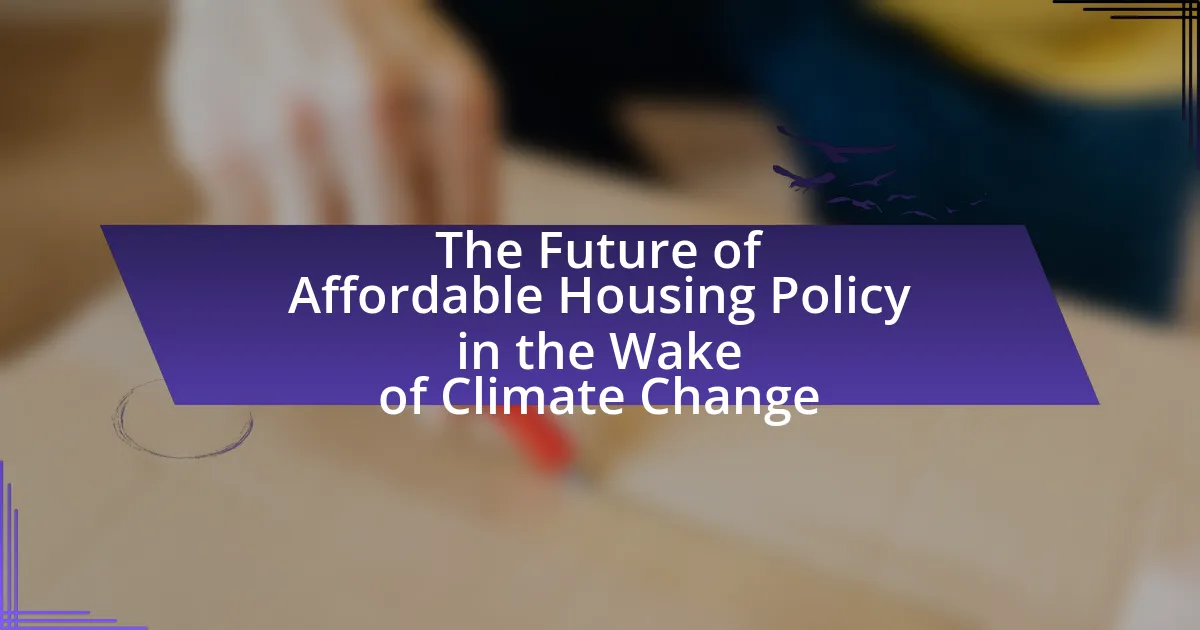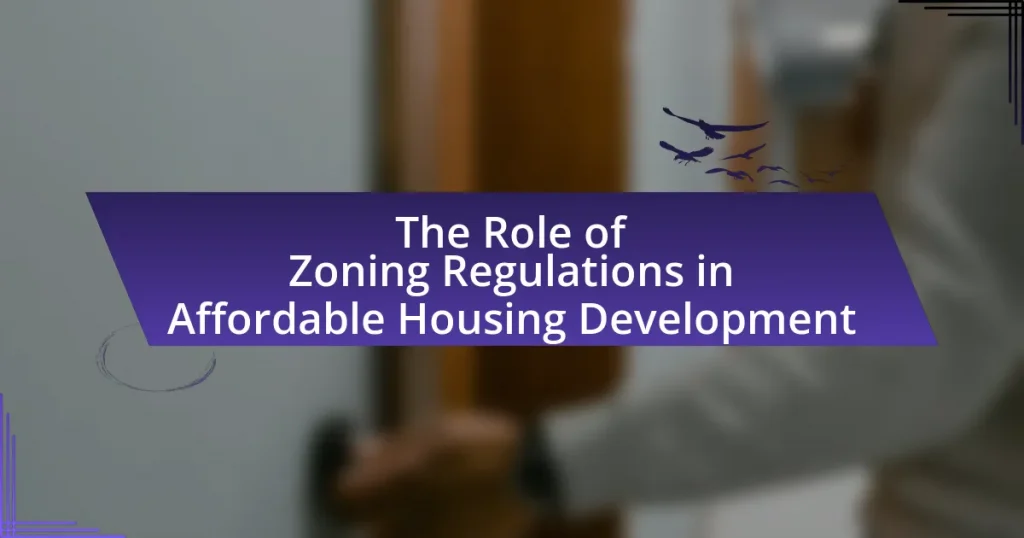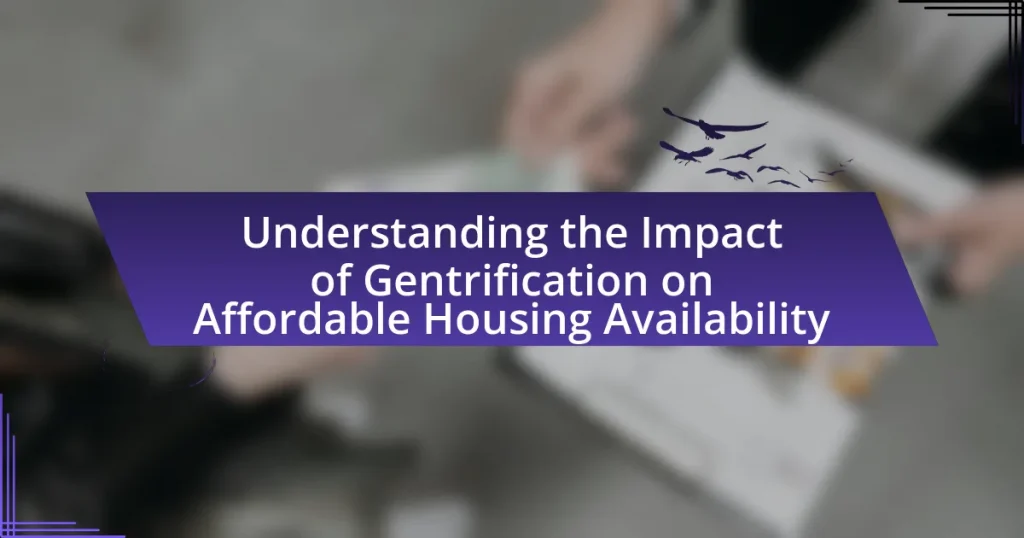The article focuses on the future of affordable housing policy in the context of climate change, emphasizing the need for sustainability and resilience in housing development. It outlines how climate change is impacting housing policies, highlighting the challenges posed by extreme weather events and rising sea levels, particularly for low-income communities. The article discusses current adaptations in policies, including the integration of energy-efficient practices and funding mechanisms that prioritize green building. Additionally, it explores the role of affordable housing in community resilience, carbon footprint reduction, and innovative solutions that leverage new technologies and public-private partnerships to address the dual challenges of affordability and environmental sustainability.
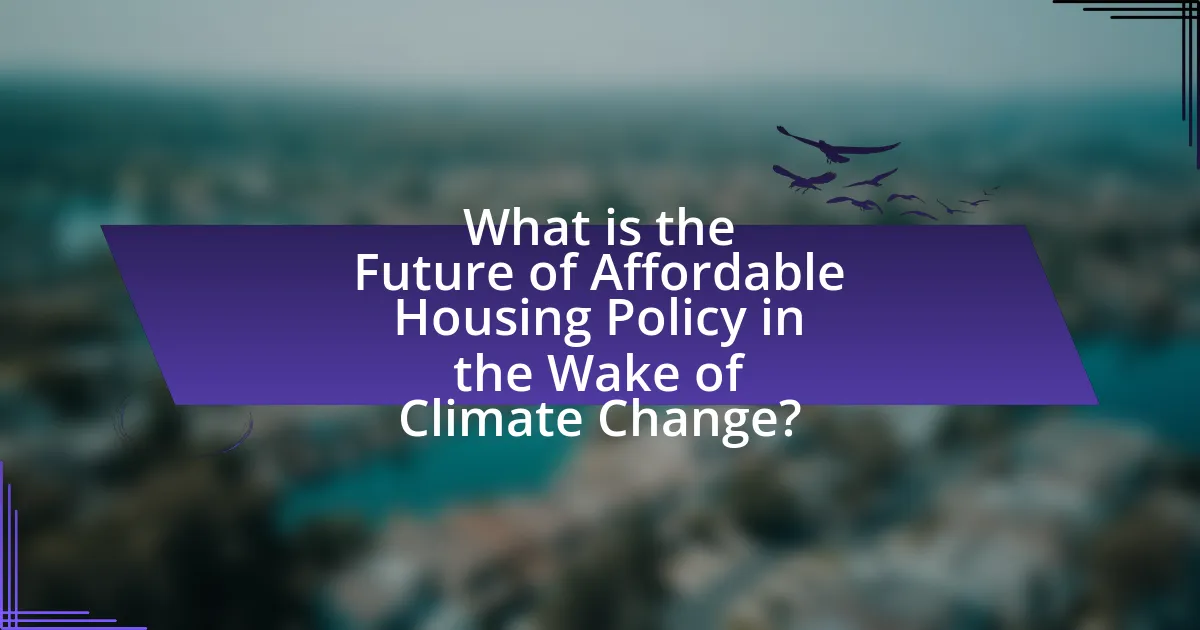
What is the Future of Affordable Housing Policy in the Wake of Climate Change?
The future of affordable housing policy in the wake of climate change will increasingly focus on sustainability and resilience. Policymakers are recognizing the need to integrate climate adaptation strategies into housing development to ensure that affordable housing can withstand extreme weather events and rising sea levels. For instance, the National Low Income Housing Coalition emphasizes that affordable housing must be built with energy-efficient materials and designs to reduce long-term costs and environmental impact. Additionally, funding mechanisms such as the Low-Income Housing Tax Credit are being adapted to prioritize projects that incorporate green building practices, reflecting a shift towards environmentally responsible development. This alignment of affordable housing with climate resilience is crucial, as studies show that low-income communities are disproportionately affected by climate change, necessitating targeted policies that address both housing affordability and environmental sustainability.
How is climate change impacting affordable housing policies?
Climate change is significantly impacting affordable housing policies by increasing the urgency for resilience and sustainability in housing development. As extreme weather events become more frequent and severe, policymakers are compelled to integrate climate adaptation strategies into housing regulations. For instance, the National Oceanic and Atmospheric Administration reported that climate-related disasters have caused over $1 trillion in damages in the past decade, prompting local governments to prioritize building codes that enhance structural resilience. Additionally, rising sea levels and urban heat islands are leading to a reassessment of land use, often resulting in the displacement of low-income communities. This necessitates the creation of policies that not only provide affordable housing but also ensure that these homes are located in safer, less vulnerable areas.
What specific challenges does climate change pose to affordable housing?
Climate change poses significant challenges to affordable housing by increasing the frequency and severity of natural disasters, which can lead to property damage and displacement. For instance, rising sea levels and extreme weather events, such as hurricanes and floods, threaten low-income neighborhoods that often lack adequate infrastructure and resources for recovery. Additionally, the rising costs of construction materials and insurance due to climate-related risks make it more difficult to develop and maintain affordable housing. According to the National Low Income Housing Coalition, the cost of building affordable housing has increased by 30% over the past decade, largely driven by climate-related factors. These challenges create a cycle of vulnerability for low-income families, making it harder for them to secure stable housing in the face of climate change.
How are current policies adapting to these challenges?
Current policies are adapting to the challenges of affordable housing in the context of climate change by integrating sustainability measures and resilience planning into housing development frameworks. For instance, many jurisdictions are now mandating energy-efficient building standards and incentivizing the use of renewable energy sources in new housing projects. According to the U.S. Green Building Council, buildings that meet green standards can reduce energy consumption by up to 30%, which directly addresses both affordability and environmental impact. Additionally, policies are increasingly focusing on retrofitting existing housing stock to withstand climate-related events, thereby protecting vulnerable populations from displacement. These adaptations are essential as climate change poses significant risks to housing stability and affordability.
Why is affordable housing crucial in the context of climate change?
Affordable housing is crucial in the context of climate change because it ensures that vulnerable populations can access safe and resilient living conditions amid increasing environmental risks. As climate change exacerbates extreme weather events, affordable housing can be designed to withstand these challenges, reducing the risk of displacement for low-income families. Furthermore, affordable housing initiatives often incorporate sustainable building practices, which can lower energy consumption and greenhouse gas emissions, contributing to climate mitigation efforts. According to the U.S. Department of Housing and Urban Development, investing in affordable housing can lead to improved community resilience, as it provides stability for families during climate-related disruptions.
What role does affordable housing play in community resilience?
Affordable housing is crucial for community resilience as it provides stable living conditions that enable residents to withstand and recover from economic and environmental shocks. Stable housing reduces vulnerability to displacement during crises, such as natural disasters or economic downturns, allowing communities to maintain social cohesion and support networks. Research indicates that communities with affordable housing options are better equipped to respond to climate-related challenges, as residents are less likely to be forced into precarious living situations that can exacerbate the impacts of such events. For instance, a study by the Urban Institute found that affordable housing contributes to lower rates of homelessness and improves access to essential services, which are vital during emergencies.
How does affordable housing contribute to reducing carbon footprints?
Affordable housing contributes to reducing carbon footprints by promoting energy-efficient building practices and reducing transportation emissions. Energy-efficient designs, such as better insulation and energy-efficient appliances, lower energy consumption, which directly decreases greenhouse gas emissions. Additionally, affordable housing is often located in urban areas, closer to public transportation and essential services, which reduces the reliance on personal vehicles. According to the U.S. Department of Energy, energy-efficient homes can reduce energy use by 30% to 50%, significantly lowering carbon emissions associated with residential energy consumption. Furthermore, studies show that urban living can reduce transportation-related emissions by up to 40% compared to suburban living, highlighting the environmental benefits of affordable housing in urban settings.

What are the key components of effective affordable housing policy?
The key components of effective affordable housing policy include adequate funding, inclusive zoning regulations, and sustainable development practices. Adequate funding ensures that resources are available for the construction and maintenance of affordable housing units, which is critical given that the National Low Income Housing Coalition reported a shortage of 7 million affordable rental homes for extremely low-income renters in the United States. Inclusive zoning regulations promote diverse housing options and prevent displacement, allowing for mixed-income communities. Sustainable development practices are essential in addressing climate change impacts, as they incorporate energy-efficient designs and materials, which can reduce long-term costs and environmental footprints. These components collectively contribute to a robust framework for addressing the affordable housing crisis while considering future climate challenges.
How can policy frameworks be designed to address climate change?
Policy frameworks can be designed to address climate change by integrating sustainability principles into housing regulations and incentives. This involves establishing guidelines that promote energy efficiency, renewable energy use, and resilient infrastructure in affordable housing developments. For instance, the implementation of building codes that require the use of sustainable materials and energy-efficient technologies can significantly reduce carbon footprints. Additionally, financial incentives such as tax credits for developers who incorporate green building practices can encourage the construction of eco-friendly housing. Evidence from the U.S. Green Building Council indicates that green buildings can reduce energy consumption by up to 30%, demonstrating the effectiveness of such policy measures in combating climate change.
What best practices exist for integrating sustainability into housing policies?
Best practices for integrating sustainability into housing policies include implementing energy-efficient building codes, promoting the use of renewable energy sources, and incentivizing sustainable materials in construction. Energy-efficient building codes, such as those adopted in California’s Title 24, have been shown to reduce energy consumption by up to 50%, demonstrating their effectiveness. Additionally, policies that encourage the installation of solar panels and other renewable energy systems can significantly lower greenhouse gas emissions and utility costs for residents. Incentives for using sustainable materials, such as tax credits or grants, can further promote environmentally friendly construction practices, contributing to long-term sustainability in housing.
How can local governments implement these frameworks effectively?
Local governments can implement affordable housing frameworks effectively by integrating climate resilience into planning and policy development. This involves conducting comprehensive assessments of local housing needs and vulnerabilities to climate change, ensuring that new developments meet sustainability standards, and utilizing funding mechanisms such as grants and public-private partnerships. For instance, the U.S. Department of Housing and Urban Development (HUD) provides resources and guidelines for local governments to enhance their housing policies in the context of climate adaptation. By aligning housing strategies with climate action plans, local governments can create more resilient communities while addressing the affordable housing crisis.
What innovative solutions are emerging in affordable housing?
Innovative solutions emerging in affordable housing include modular construction, which significantly reduces building time and costs, and the use of sustainable materials that lower environmental impact. For instance, modular homes can be constructed in factories and assembled on-site, leading to a 20-30% reduction in construction costs and time, as reported by the National Institute of Building Sciences. Additionally, the integration of renewable energy technologies, such as solar panels and energy-efficient appliances, not only lowers utility costs for residents but also aligns with climate resilience strategies. These approaches are increasingly being adopted in urban planning to address the dual challenges of affordability and sustainability in housing.
How are new technologies influencing affordable housing development?
New technologies are significantly influencing affordable housing development by enhancing construction efficiency and reducing costs. Innovations such as modular construction, 3D printing, and smart building technologies streamline the building process, allowing for faster project completion and lower labor expenses. For instance, a report from McKinsey & Company indicates that modular construction can reduce project timelines by up to 50% and costs by 20%. Additionally, smart technologies improve energy efficiency, which lowers utility costs for residents, making housing more affordable in the long term. These advancements not only address immediate housing needs but also contribute to sustainable development in the context of climate change.
What role do public-private partnerships play in these innovations?
Public-private partnerships (PPPs) play a crucial role in driving innovations in affordable housing policy, particularly in the context of climate change. These collaborations leverage the strengths of both sectors, combining public resources and regulatory frameworks with private sector efficiency and investment. For instance, PPPs facilitate the development of sustainable housing projects that incorporate green technologies, which are essential for reducing carbon footprints and enhancing resilience to climate impacts. Evidence of their effectiveness can be seen in initiatives like the Green Building Council’s partnerships, which have led to the construction of energy-efficient homes that meet both affordability and environmental standards.
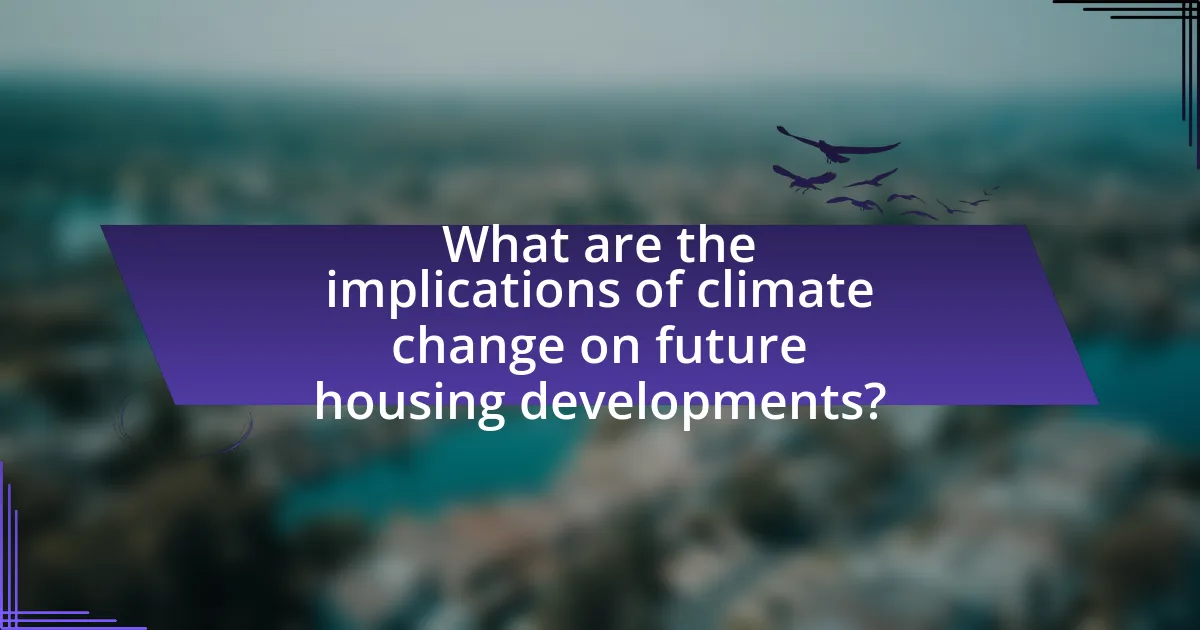
What are the implications of climate change on future housing developments?
Climate change significantly impacts future housing developments by necessitating the integration of sustainable practices and resilience strategies. As extreme weather events become more frequent, housing designs must adapt to withstand flooding, heatwaves, and other climate-related challenges. For instance, the National Oceanic and Atmospheric Administration (NOAA) reports that sea levels are rising at an average rate of 3.3 millimeters per year, which directly affects coastal housing developments. Additionally, the U.S. Green Building Council emphasizes that energy-efficient building materials and renewable energy sources are essential for reducing carbon footprints and ensuring long-term sustainability. Therefore, future housing developments will increasingly prioritize eco-friendly designs and locations that mitigate climate risks, ultimately shaping urban planning and policy decisions.
How will climate resilience shape future housing designs?
Climate resilience will significantly shape future housing designs by prioritizing sustainable materials, energy efficiency, and adaptive architecture. As climate change increases the frequency of extreme weather events, housing designs will incorporate features such as elevated structures to mitigate flooding, reinforced materials to withstand storms, and energy-efficient systems to reduce carbon footprints. For instance, the U.S. Green Building Council reports that buildings designed with resilience in mind can reduce energy consumption by up to 30%. Additionally, integrating green roofs and rainwater harvesting systems will enhance water management and biodiversity, aligning with the growing emphasis on environmental sustainability in housing policies.
What materials and construction methods are being prioritized?
Sustainable materials and modular construction methods are being prioritized in affordable housing policy in response to climate change. Sustainable materials, such as recycled steel, bamboo, and rammed earth, reduce environmental impact and enhance energy efficiency. Modular construction methods, which involve prefabricating building components off-site, streamline the construction process, minimize waste, and lower costs. Research indicates that these approaches can significantly decrease carbon footprints and improve the resilience of housing against climate-related challenges.
How can urban planning adapt to climate-related challenges?
Urban planning can adapt to climate-related challenges by integrating sustainable design principles, enhancing infrastructure resilience, and promoting green spaces. Sustainable design principles, such as energy-efficient buildings and renewable energy sources, reduce carbon footprints and mitigate climate impacts. Infrastructure resilience can be improved through the use of flood-resistant materials and the implementation of stormwater management systems, which are essential in areas prone to flooding. Additionally, promoting green spaces not only improves urban biodiversity but also helps in cooling urban heat islands, thereby addressing temperature increases associated with climate change. These strategies are supported by research indicating that cities implementing such adaptive measures experience reduced vulnerability to climate impacts, as seen in cities like Rotterdam and Copenhagen, which have successfully integrated climate adaptation into their urban planning frameworks.
What strategies can be employed to ensure affordability amidst climate change?
To ensure affordability amidst climate change, implementing policies that promote energy efficiency and sustainable building practices is essential. Energy-efficient homes reduce utility costs, making housing more affordable for residents. For instance, the U.S. Department of Energy reports that energy-efficient upgrades can save homeowners an average of 30% on energy bills. Additionally, incentivizing the use of renewable energy sources, such as solar panels, can further decrease long-term costs for residents. Local governments can also adopt zoning reforms that allow for higher-density housing, which can lower per-unit costs and increase the availability of affordable options. These strategies collectively address the financial burdens posed by climate change while promoting sustainable living environments.
How can funding models be adjusted to support affordable housing?
Funding models can be adjusted to support affordable housing by increasing public investment, leveraging private capital, and implementing innovative financing mechanisms. Public investment can be enhanced through government subsidies and tax incentives, which have been shown to stimulate the construction of affordable units; for instance, the Low-Income Housing Tax Credit has facilitated the development of over 3 million affordable homes since its inception in 1986. Additionally, public-private partnerships can attract private capital, allowing for shared risk and increased funding availability. Innovative financing mechanisms, such as social impact bonds, can also be utilized to fund affordable housing projects while ensuring accountability and measurable outcomes. These adjustments can create a more sustainable and effective funding landscape for affordable housing in the context of climate change.
What policies can incentivize sustainable practices in housing development?
Policies that can incentivize sustainable practices in housing development include tax credits for energy-efficient building materials, grants for renewable energy installations, and zoning regulations that promote green spaces. These policies encourage developers to adopt environmentally friendly practices by reducing costs and increasing the marketability of sustainable housing. For instance, the U.S. federal government offers the Energy Efficient Home Credit, which provides a tax incentive for builders who construct homes meeting specific energy efficiency standards. Additionally, local governments can implement density bonuses for projects that incorporate sustainable design features, thereby promoting higher density development while supporting environmental goals.
What practical steps can communities take to enhance affordable housing policies?
Communities can enhance affordable housing policies by implementing inclusionary zoning, which requires developers to allocate a percentage of new housing units for low-income residents. This approach has been successfully adopted in cities like San Francisco, where inclusionary zoning has increased the availability of affordable units by approximately 20% in new developments. Additionally, communities can establish land trusts to acquire and manage land for affordable housing, ensuring long-term affordability and stability. For instance, the Champlain Housing Trust in Vermont has created over 2,000 affordable homes through this model. Furthermore, communities should advocate for increased funding for affordable housing through local, state, and federal programs, as evidenced by the National Low Income Housing Coalition’s report indicating that every $100 increase in rent results in a loss of 7.5 million affordable units nationwide. By combining these strategies, communities can effectively address the challenges of affordable housing in the context of climate change.
